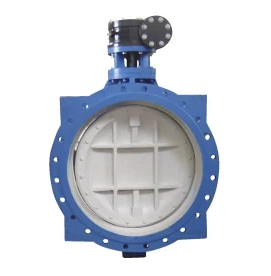High-performance butterfly valves (HPBV) are generally capable of performing well in abrasive fluid environments, provided they are properly selected and designed for such conditions.
Here’s how HPBV typically perform in abrasive fluid environments:
- Material Selection: HPBV used in abrasive fluid environments are often constructed from materials with high abrasion resistance, such as stainless steel, duplex stainless steel, or special alloys like Stellite. These materials can withstand the erosive effects of abrasive particles in the fluid.
- Hardened Components: The valve components, including the disc and seat, may be hardened or coated with abrasion-resistant materials to minimize wear and prolong service life. Hardened surfaces can withstand the impact of abrasive particles and maintain sealing integrity over time.
- Streamlined Flow Path: HPBV are designed with a streamlined flow path to minimize turbulence and reduce the erosive effects of abrasive particles on internal surfaces. Smooth flow paths help mitigate erosion and maintain valve performance.
- Maintenance and Inspection: Regular maintenance and inspection are essential for HPBV operating in abrasive fluid environments. hp butterfly valve Periodic inspection of valve components for signs of wear or damage allows for timely replacement or repair, ensuring continued performance.
- Controlled Flow Velocity: Controlling the flow velocity through the valve can help minimize erosion in abrasive fluid environments. Proper sizing and flow control measures can reduce the impact of abrasive particles on valve components.
- Optional Features: Some HPBV may offer optional features specifically designed for abrasive fluid applications, such as hard-faced discs and seats, abrasion-resistant coatings, or replaceable wear parts. These features enhance the valve’s ability to withstand abrasive wear and extend its service life.
- System Design Considerations: Proper system design, including the use of filters, strainers, or settling chambers upstream of the valve, can help remove or reduce the concentration of abrasive particles in the fluid, thereby reducing erosion on valve components.
Overall, HPBV can perform effectively in abrasive fluid environments when they are selected, designed, and maintained appropriately. Proper material selection, hardened components, streamlined flow paths, and proactive maintenance are key factors in ensuring reliable performance and longevity in such applications.

How does the hp butterfly valve perform in abrasive fluid environments?
